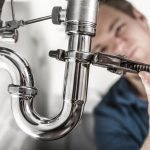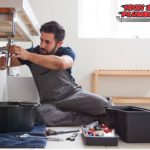Many people are interested in saving money in their wallet by trying to keep their homes in working condition on their own. That means learning how to perform plumbing and repair jobs instead of calling a professional. It can be a daunting task, but if you have your heart set on getting the job done, here are the seven must-have tools you need for your plumber’s tool bag before you start:
1. Locking Pliers
These are also called vise-grips and are very useful when taking care of the plumbing in your bathroom or kitchen. They are good at holding objects in place when you need to screw or unscrew certain things, like pipe-joints, washers, and nuts/bolts. Having a good pair of locking pliers will reduce the strain of having to loosen or tighten connection points.
2. Basin Wrench
The basin wrench is a tool in plumbing that is designed to remove nuts from hard-to-reach spots, such as under sinks. Other types of wrenches do not work very well on the nuts that connect the faucet to the sink, so that is why the basin wrench is perfect for the job. There are three basic types: fixed basin wrenches, adjustable basin wrenches, and plastic nut basin wrenches.
3. Needle Nose Pliers
For those small spaces that you cannot reach with your fingers, needle nose plier are great at grabbing and gripping small objects. They are also great at bending and shaping wires, cutting small tubing, and locking onto small objects that need to be held in place.
4. Strap Wrench
Strap wrenches are great at what they do, because they are completely adjustable. They use the tension of a rubber or polyester strap to grip and turn things without scratching or damaging them in the process. That makes them very versatile in many plumbing jobs, especially when other tools are not available.
They are also extremely easy to use, so you do not have to have a degree in order to make it work for you. There are indicators telling you which way you should hold it and then you just tighten the strap around whatever you are using it on.
5. Caulking Tools
Caulk is used as a sealant around areas and appliances where water is involved. Because of this, it is usually made from latex or silicone, as both materials are very water-resistant.
Of course, you need some way of applying the caulk, and that means using a caulking gun or a cartridge. Overall, the caulking gun is much better, as you get a steadier flow of the caulk as you are using it so that there are no gaps in your project.
6. Plumber’s Tape
This is also called Teflon tape and is used on pipe joints to create a watertight seal. The tape is placed on the threading of a pipe before the pipes are screwed together to ensure that no water leaks from them. This tape also prevents the pipes from sticking together when they need to be taken apart. Plumber’s tape is extremely easy to use but you should still learn how to apply it properly.
7. Plumber’s Putty
This is a type of putty that is used as a sealant. It creates watertight seals around drains and faucets so that there is no water damage to the surrounding area. Plumber’s putty can be made from various materials, including clay, limestone, or talc, but every manufacturer is going to have their own formula. It is one of the most essential components needed when doing plumbing jobs.
Before you even start thinking about doing DIY plumbing repair jobs on your own, it is important that you have these seven basic components and do the proper research on how to protect your home while you are working. You do not want to end up flooding your entire home, because you forgot to turn off your water main.







